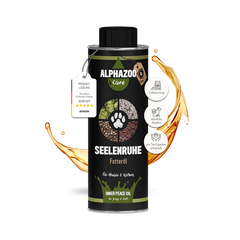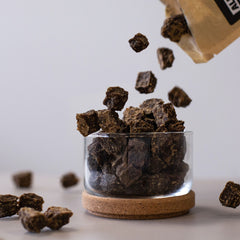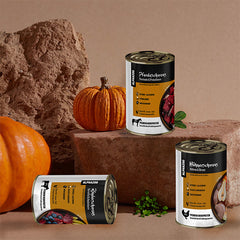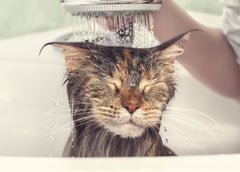Chocolate for cats – Why it can be a deadly danger
A small piece of chocolate can't hurt your four-legged friend, can it? Wrong! While it's a delicious treat for us humans, chocolate poses a serious danger to cats. But why is that? The culprit is theobromine – a substance that is life-threatening for cats.
In this blog, I'll explain why chocolate is taboo for cats, what symptoms indicate poisoning, and how to act correctly in an emergency.
Why is chocolate toxic to cats? Theobromine is to blame.
Chocolate contains theobromine , a substance in the methylxanthine family. While humans can easily process this substance, cats (and dogs) lack the enzyme to effectively break down theobromine.
What happens in the cat’s body?
- Theobromine accumulates in the blood.
- The nervous system, heart and circulatory system are massively affected.
- Even small amounts can lead to symptoms of poisoning.
The degree of danger depends on:
- The amount of chocolate consumed.
- The type of chocolate (dark chocolate is more dangerous than milk chocolate).
- The weight and health of your cat.
Note: Even 20 mg of theobromine per kilogram of body weight can be fatal!
Types of chocolate: Which is most dangerous for cats?
Not all chocolate contains the same amount of theobromine. Here's an overview:
- Dark chocolate & semisweet chocolate: Contains the highest amount of theobromine – absolutely dangerous!
- Milk chocolate: Contains less theobromine, but is still toxic.
- White chocolate: Low amounts of theobromine, but the high fat and sugar content is unhealthy.
Caution: The darker and purer the chocolate, the more dangerous it is for your cat.
Symptoms of chocolate poisoning in cats
Has your cat eaten chocolate? Then you should act quickly! Look out for the following symptoms:
First signs:
- Restlessness and nervousness
- Tremble
- Vomiting and diarrhea
Advanced symptoms:
- Increased heart rate (tachycardia)
- breathing difficulties
- Muscle cramps
- Severe tremors or seizures
Life-threatening symptoms:
- Cardiac arrhythmias
- Circulatory collapse
- coma
Tip: Symptoms often appear 2–4 hours after consumption and can last up to 24 hours. So, taking action is paramount!
My cat ate chocolate – what should I do?
Don’t panic, but quick action is required now:
- Contact your veterinarian immediately: Describe exactly what and how much your cat ate.
- Don't waste time: The sooner your cat is treated, the higher the chances of survival.
- Do not use home remedies: Do not try to make your cat vomit – this can be dangerous.
Important information for the veterinarian:
- Cat's weight
- Amount and type of chocolate
- Time of consumption
How can you stop your cat from eating chocolate?
Prevention is the best protection. Here are a few tips:
- Store chocolate safely: Never leave chocolate lying around – cats are curious!
- Avoid table scraps: Do not share food with your cat that may contain chocolate.
- Raise children’s awareness: Explain to children why chocolate is dangerous for cats.
- Decorate safely: Avoid chocolate decorations on holidays like Christmas or Easter.
Tip: Offer your cat suitable snacks such as cat grass or special cat treats to give them alternatives.
Home remedies and myths – do they really help?
There are many myths surrounding poisoning in cats. Here are a few you should avoid:
- “Milk helps against poison!” False – milk can make the situation worse.
- “Inducing vomiting is always good.” No – that can lead to further complications.
The best advice remains: Go to the vet!
Why cats are often not interested in chocolate
Unlike dogs, cats have a less developed sense of sweetness. This is because they lack the receptors for sweet taste . Nevertheless, some curious cats will try chocolate out of boredom or curiosity.
Tip: Never leave chocolate lying around unattended – whether your cat shows interest in it or not.
Healthy alternatives for those with a sweet tooth
Want to do something good for your cat without risk? Here are healthy alternatives:
- Sugar-free cat snacks: Specially made for cats.
- Fresh chicken or turkey: A delicious protein snack.
- Cat grass: Supports digestion and satisfies the chewing instinct.
Conclusion: Chocolate is an absolute no-go for cats!
Chocolate may be a treat for us, but for cats it's a life-threatening danger. The ingredient theobromine can cause severe poisoning even in small amounts.
The most important points summarized:
- Chocolate is poisonous to cats – especially dark varieties.
- Symptoms such as vomiting, tremors and difficulty breathing require immediate action.
- In case of emergency, the veterinarian should always be contacted.
- Prevention is the best protection: Store chocolate safely.
With this information, you can protect your cat from the hidden dangers of chocolate and give her a healthy, happy life. 🐾
















